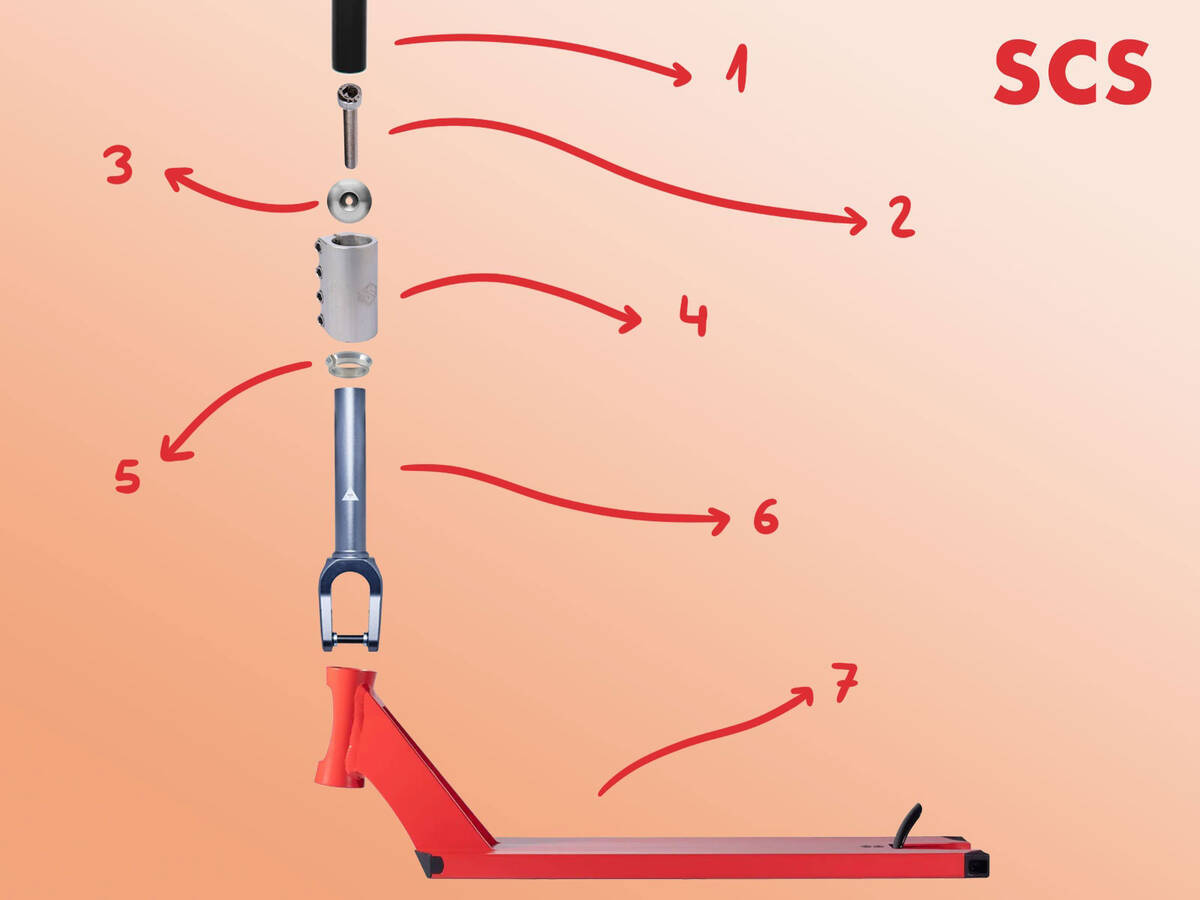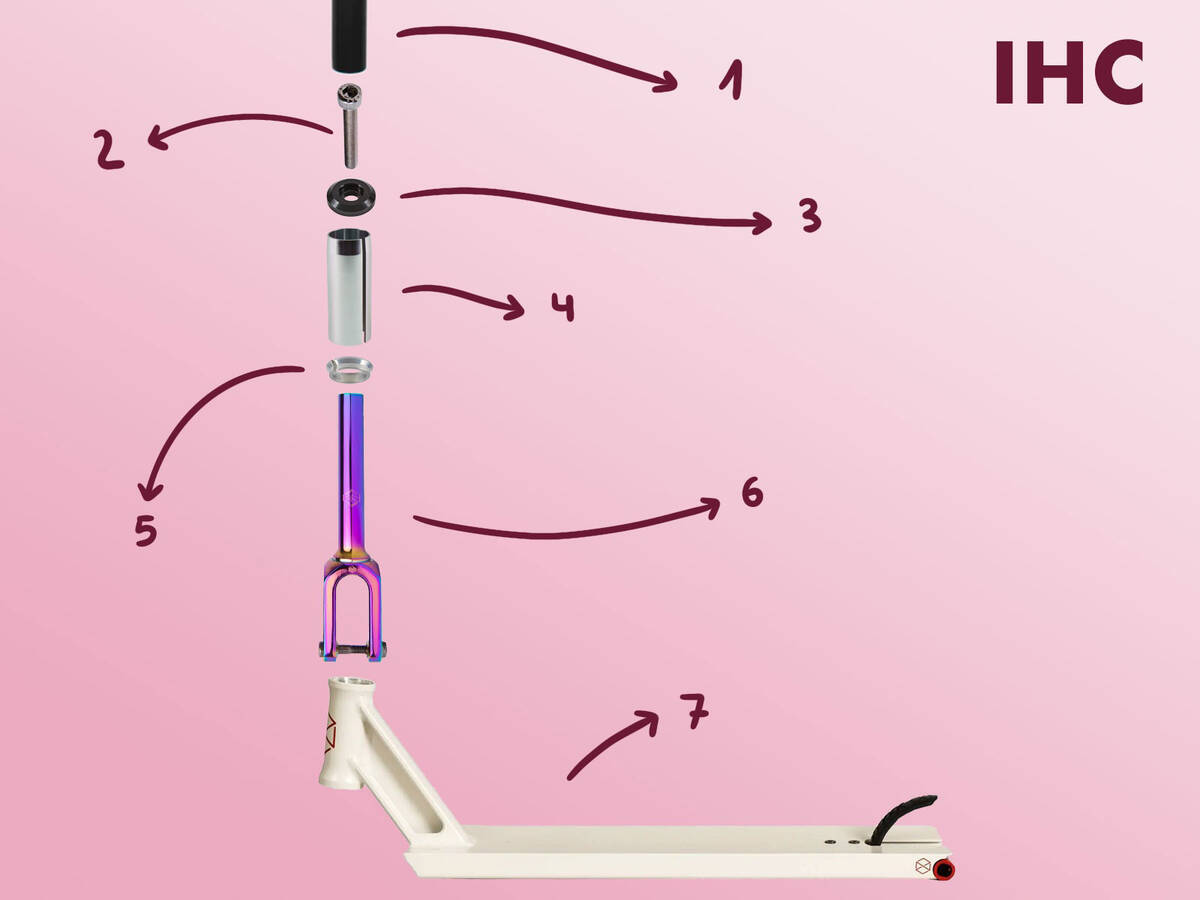Guide to Compression Systems for Scooters

Stunt scooter compression systems are crucial for your setup. They ensure a solid link between your bar, headset, and fork. Whether you're a novice or an intermediate scooter enthusiast seeking a new compression kit, this guide offers an opportunity to grasp the key principles of pro scooter compression.
We shall detail the advantages and disadvantages of the most prevalent compression systems and examine their compatibility with other scooter parts. Ultimately, you'll understand which type of compression suits your needs and how to maximise your stunt scooter's performance.
SCS Compression Explained

1: Bar (no slit) 2: Compression Bolt 3: Top Cap 4: SCS Clamp 5: C-Ring 6: Fork 7: Deck (headtube & headset)
SCS stands for Standard Compression System. Favoured for its durability and straightforwardness, SCS compression is the top choice for intensive riding. Though SCS is slightly heavier, it is arguably the most robust system and works with both standard and oversized bars, which is an advantage.
Installing SCS Compression
The setup involves mounting the clamp to the fork with an internal compression bolt and top cap pressing down on an edge within the clamp. This bolt is threaded into a starnut or pre-threaded fork (most modern SCS forks include built-in threads). The clamp secures the bar and is tightened with four bolts.
Watch the following video to learn how to install SCS compression:
Bars Compatible with SCS
For SCS configurations, bars without slits are necessary. A bar with a slit can break as the clamp will compress the slit. Options include cutting the bar to remove the slit or using an SCS bar adapter.
Clamps Compatible with SCS
An SCS clamp is required as the compression mechanism is part of the clamp. Ensure the clamp's inner diameter matches the outer diameter of your bars, either 32 mm (standard) or 35 mm (oversized).
Notice: If the inner edge of the SCS clamp isn’t positioned above the top of the fork, you won't achieve a proper connection. Use a headset spacer to elevate the clamp accordingly.
Forks Compatible with SCS
HIC and SCS forks are suitable for SCS compression (HIC and SCS forks are identical).
Understanding HIC Compression

1. Bar 2. Compression Bolt 3. Top Cap 4. IHC Shim 5. C-Ring 6. Fork 7. Deck (headtube & headset)
HIC denotes Hidden Internal Compression. It’s not the lightest, but HIC is preferred for being lighter than SCS and relatively easy to install. However, it needs a bar with a slit at the bottom, which is a weak point absent in heavier SCS compression.
HIC Compression Installation
An HIC shim is placed on the fork, and a compression bolt with a top cap presses the shim onto the scooter deck's headtube to secure the fork. A clamp tightens the bar around the fork's tube.
Watch the video below to learn about fitting an HIC compression system:
Bars Compatible with HIC
These bars must have a 32 mm inner diameter and a 35 mm outer diameter, made from sturdy materials like steel or titanium. Aluminium bars with oversized outer diameters but smaller inner diameters aren't suitable due to extra thick tubing needed for durability during strenuous riding. HIC bars feature a slit at the base.
Clamps for HIC Systems
Your HIC clamp must cover the full slit length in your bar. Get a 35 mm inner diameter clamp (oversized) for your HIC setup.
Forks Suitable for HIC
HIC/SCS forks work with HIC compression.
Note: Suggest using an HIC spacer before placing the shim onto the fork to achieve adequate compression and proper setup tightening.
Exploring IHC Compression

1. Bar 2. Compression Bolt 3. Top Cap 4. IHC Shim 5. C-Ring 6. Fork 7. Deck (headtube & headset)
IHC, or Internal Hidden Compression, mirrors many aspects of HIC. Its primary benefit is providing a lightweight setup paired with strong compression.
The notable distinction is the slimmer shaft or fork tube in IHC forks. This allows them to work with bars that have a 28 mm inner diameter, thus being compatible with aluminium bars of a standard 28 mm inner diameter and a 35 mm oversized outer diameter.
Installing IHC Compression
An IHC compression ring goes within the headset bearing for the narrower fork tube, which prevents any slack or movement between the fork and bearing.
Then, mount an IHC shim on the fork tube, lay a top cap above it, and engage the compression bolt into the fork's threads. Once tightened, it presses down on the top cap for compression.
Watch this video to learn how to install IHC compression:
IHC-Compatible Bars
IHC is suitable for bars with a 28 mm inner diameter and a slit at the bottom.
IHC accommodates all bars with this standard 28 mm inner diameter and bottom slit.
You'll need an adapter to use larger steel or titanium bars with an IHC fork due to their bigger inner diameters.
IHC-Compatible Clamps
Check that your clamp's inner diameter aligns with your bar's outer diameter.
Forks Compatible with IHC
Using IHC forks is essential for IHC compression. These have thin shafts to cut down on weight and, unlike HIC, an IHC fork can work with bars with a regular inner diameter of 28 mm.
Note: The IHC shim must extend over the area of the fork tube that emerges from the headtube. Without this, achieving proper compression isn't possible, and a headset spacer should be used to facilitate correct tightening.
ICS Compression Details
ICS means Inverted/Internal Compression System, distinguished by its lightweight nature and affordability. It involves the fewest components compared to other compression systems.
The downsides of ICS are primarily related to installation and upkeep, which can be somewhat tricky. It may appeal to riders focused on park situations with excellent landing control, but its durability is far inferior to that of SCS.
ICS Compression Installation
Within an ICS setup, a bolt fits through the fork from below. The bolt's portion extending from the fork threads into a starnut inside the bar. It involves fewer components than other compression systems.
Installing and maintaining it can be burdensome. The front wheel has to be removed to adjust the compression bolt. For instance, if you wish to detach your bar, you need to remove the front wheel and subsequently undo the compression bolt entirely.
Watch the video to grasp the ICS compression installation:
Bars for ICS Compression
ICS relies on a starnut to secure firmly in the bar. In most steel and titanium bars, the surface is smooth and hard, causing starnuts to slide and eventually loosen compression. Aluminium's softer, so starnuts grip more securely in it.
Therefore, for ICS compression, either an aluminium bar or a bar with a built-in starnut is recommended.
ICS bars generally have a 28 mm inner diameter and a bottom slit, similar to IHC and HIC bars. The outer diameter may vary from 32 mm to 35 mm, so it's crucial your clamp’s inner diameter aligns with your bar's outer diameter.
ICS-10 Compression Overview
The ICS-10 compression system resembles the standard ICS closely, with the difference being the compression bolt thread size.
ICS-10 compression uses M10 threaded bolts, whereas regular ICS employs M6 threads.
The bolts are slightly more robust than the thinner M6 variant.
Watch the video to understand mounting ICS-10 compression:
Video Guide: Compression Systems Explained
Delve into this explainer video for expert insights on scooter compression systems. Discover details about SCS, HIC, IHC, and ICS-10 systems.
